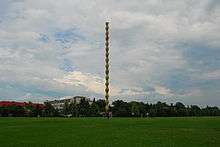Sculptural Ensemble of Constantin Brâncuși at Târgu Jiu
Coordinates: 45°02′22″N 23°16′07″E / 45.0394°N 23.2687°E
The Sculptural Ensemble of Constantin Brâncuși at Târgu Jiu is an homage to the Romanian heroes of the First World War. The ensemble comprises three sculptures: the Table of Silence, the Gate of the Kiss and the The Infinity Column, on an axis 1,300 m (4,250 ft) long, oriented west to east. The ensemble is considered to be one of the great works of 20th-century outdoor sculpture.
History
The monument was commissioned by the National League of Gorj Women to honor those soldiers who had defended Târgu Jiu in 1916 from the forces of the Central Powers. Constantin Brâncuși (1876–1957) was at the time living in Paris, but welcomed the opportunity to create a large commemorative sculpture in his homeland. He accepted the commission in 1935, but refused to receive payment for it.
The Infinity Column
The Infinity Column symbolizes the concept of Infinity and the infinite sacrifice of the Romanian soldiers. It is considered by Sydnei Geist the top point of the modern art. The Infinity Column stacks 17 rhomboidal modules, with a half-unit at the top. The incomplete top unit is thought to be the element that expresses the concept of the infinite.[1] Brâncuși had experimented with this form as early as 1918, with an oak version now found in the collection of the Museum of Modern Art in New York City.[2] The modules were made in the central workshop of Petroşani (Atelierele Centrale Petroşani), assembled by Brâncuși's friend engineer Ştefan Georgescu-Gorjan (1905–1985), and completed on October 27, 1938. All 17 rhomboidal modules accumulate a total height of 29.3 m.[3]
In the 1950s, the Romanian communist government planned to demolish the column, but this plan was never executed. After the Romanian Revolution of 1989 and the fall of the Communist regime, there was renewed interest in restoring the column, which by that time suffered from tilting, cracking, metal corrosion, and an unstable foundation. For these reasons the site was listed in the 1996 World Monuments Watch by the World Monuments Fund. The restoration was facilitated by the Fund, which organized meetings for the stakeholders in 1998 and provided funding through American Express. Subsequently, the site was restored between 1998 and 2000 through a collaborative effort of the Romanian Government, the World Monuments Fund, the World Bank, and other Romanian and international groups.[4]
Ensemble
Two other pieces constitute the Ensemble. The Table of Silence is a circular stone table surrounded by twelve hourglass-seats, which symbolize time. The Table represents the moment before the battle on which the combatants were going to participate. Nevertheless, the seats are not located close to the edges of the table. The Gate of the Kiss, of Banpotoc travertine (marble), features a kiss motif on the gate pillars. The transition to another life occurs through the Gate of Kiss. The Ensemble had been inaugurated on 27 October 1938. During the "socialist Realism" epoch, Brâncuși had been challenged as an exponent of cosmopolitan bourgeois formalism. However, in 1964 Brâncuși was "rediscovered" in Romania as a national genius, and consequently, the Ensemble of Târgu Jiu was restored, after a long period of degradation.
The name of the sculptures
Doctor Traian Stoicoiu, whose father Matei Stoicoiu was classmate with Brâncuși in primary school, has known the famous sculptor. He said the real names of Brâncuși's sculptures are:
- The Column of the infinite sacrifice given by the Romanian heroes for the Unity of the Nation. The number of component modules represents the year on which Romania came into the First World War and the ending half module represents the half part of the respective year.
- The Apostles' Table composed by 12 seats (which represent the Apostles), while in the middle there is Jesus Christ.
- The Monument of the Unity of the Nation which is made of two pillars, each of one is composed respectively by four pillars, connected on the top by a beam. The kiss means the Unity, while the eight pillars represent the eight provinces unified with the Motherland, Romania.
Gallery
References
- ↑ Alexandra Parigoris, "Brâncuși and his return to Romania," Brâncuși's Infinity Column Ensemble, ed. Ernest Beck, Scala Publishers, London: 2007, p. 12-29, p. 21.
- ↑ MoMA | The Collection | Constantin Brancusi. Endless Column. version I, 1918
- ↑ SkyscraperPage.com – The Endles Column
- ↑ World Monuments Fund - Brancusi's Endless Ensemble
External links
- Richard Newton, "Reclaiming Sacred Space: Landscaping Constantine Brancusi’s Endless Column Complex," ICON Magazine, Summer 2006, p. 32-39.
- Alexandra Parigoris, "Endless Column Restored," Sculpture, 21.1 (January/February 2002).
- The Restoration of Brancusi's 'Endless Column', World Monuments Fund.
